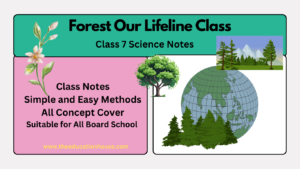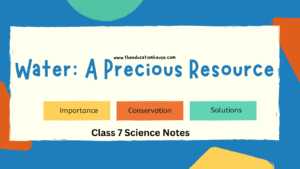Forest Our Lifeline Class 7 Notes
Introduction
Welcome to Forest Our Lifeline Class 7 Notes, a special series by The Education House under Class 7 science. In Forest Our Lifeline Class 7 Notes, we will discuss what a forest is, the types of forests, how a forest plays a role in our daily lives, and how we can protect forests. The Education House team will try its best to cover all concepts with simple and easy-to-understand methods.
Important topic which is covered in the Forest Our Lifeline Class 7 Notes
What is a forest?
Types of forests?
What is Crown in Plants?
What is Canopy?
Stratification of Forest
What is humus?
What is decomposer?
Why are forests called green lungs?
How do forests prevent floods and soil erosion?
How do forests prevent pollution?
What is afforestation?
What is deforestation?
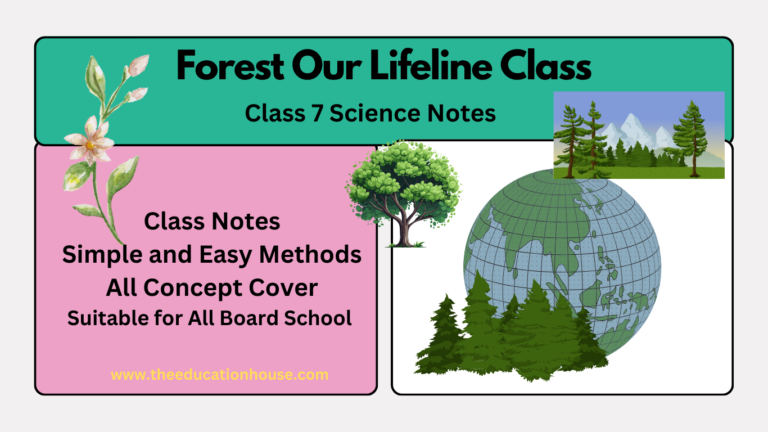
What is a forest?
To better understand, to know Forest Our Lifeline Class 7 Notes, we must know what a forest is.
- Forest is a place that is covered with a wide range of different plants.
- Forest is not only made with plants, it is also made up of many things like trees, plants, shrubs, herbs, wild animals, and birds.
- It also includes many non-living or abiotic factors such as air, water, and sunlight.
Types of Forests
There are many types of forests on earth. Its nature and varieties depend on the geographic conditions of that area. As a result of many factors and reasons, some types of forests are explained below:
- Tropical rainforests: This type of forest is found near the equator, mostly in regions like the Amazon Basin, the Congo Basin, and Southeast Asia. It is mostly in highly rainy areas.
- Temperate Forests: This type of forest is found in the temperate region, mostly in Europe, America, and Asia.
- Boreal Forests (Taiga): This type of forest is found in highly northern latitudes like Canada.
- Tropical Dry Forests: This type of forest is found in tropical and subtropical areas such as India, South Africa, and North America.
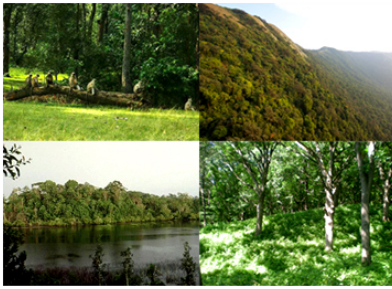
What is the crown in a Plant?
The uppermost part of any plant is known as the crown of the plant. According to the shape of the crown, it is named various types of crown. Round, spreading, paramedical, and open crown.
What is canopy?
In the forest, many trees grow together and the topmost part of these trees makes a roof-like structure after combining their leaves and branches. This roof-like structure is known as a Canopy.
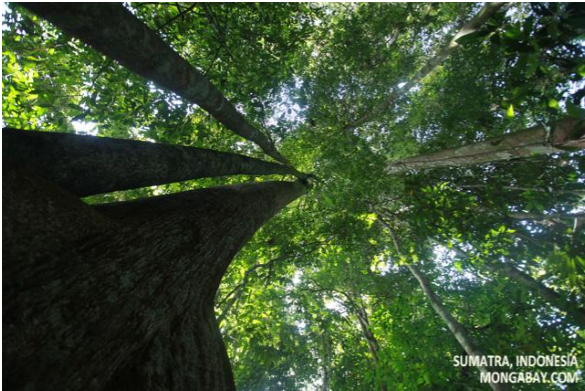
Ecological Importance of Canopy
Canopy is the most important part in the forest ecological system. Some of their importance is explained below:
- Canopy stops much sunlight, by this, the temperature of the floor forest part is very low and it is beneficial for other factors of the forest.
- Canopy is a shelter like birds and animals, and their food protects them from rain and sunlight.
Stratification in Forest
In forest our lifeline class 7 notes, the important part is stratification. For a better understanding of forests, we divide them into many levels. Some of them are explained below:
- The forest floor: this is the lowest level of forests; it contains decomposed leaves and the upper layer of soil.
- The Herb layer: this layer contains plants that have woodless stems and look like grass.
- The Shrub layer: This layer contains plants whose size is small to medium. These kinds of plants required the most sunlight.
- The Understory: This layer contains plants that grow on the forest floor but below the canopy. This type of plant required less sunlight.
- The canopy: This layer contains the crown of the plant and exposes the sunlight.
- The Emergent layer: This layer contains the topmost part of the tree. Emergent layer found in mostly tropical forests.

What is humus in forest our lifeline class 7 notes?
Humus is made up of decomposed plant and animal matter. Humus is black. Humus is rich in Carbon. Over time, microorganisms like bacteria, and fungi, dead and decaying plant and animal matter convert into humus.
What is decomposer?
The microorganisms that eat dead and decaying plants and animals and convert them into humus are known as decomposers.
Why are forests called green Lungs?
As we know, animals and humans consume oxygen for breathing and release carbon Dioxide. Plants consume carbon Dioxide and release oxygen, so it is beneficial for balancing the oxygen and carbon Dioxide ratio in the environment. So that’s why forests are known as green lungs.
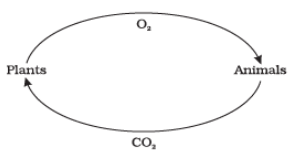
Forest Our Lifeline class 7 notes PDF
How do forests prevent floods and soil erosion?
Flood prevention
As we studied above, forests have a strong canopy, so that’s why when rain falls on it, it reduces the speed of rain fall on earth, so that’s why the soil has more time to absorb the water.
By reducing the speed of water and diverting the path of water, it absorbs by the soil instead of going to the river. So this plays a major role in preventing floods.
Prevention of Soil Erosion:
Forests have a large number of trees, which have a variety. As we studied in the chapter, Transportation in animals and plants, class 7 plants get nutrients from the roots. To absorb nutrients and water from the soil, the roots of a plant bind it. So that’s why it prevents soil erosion
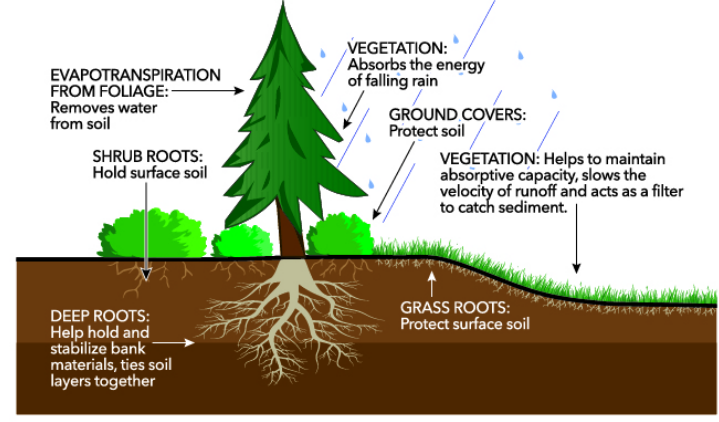
How do forests prevent pollution?
Air Quality improvement:
In our daily life, we produce a lot of carbon dioxide and carbon by using many artificial things, and as we know, plants consume carbon dioxide and produce oxygen. This is one of the main reasons forests prevent pollution.
Trees can also trap airborne pollutants like sulphur dioxide and nitrogen dioxide. The leaves of the tree absorbed these pollutants and filtered them.
Water pollution reduces
By absorbing water and maintaining the water cycle, forests help us to reduce water pollution. Absorbing water and passing it to the river is acting like a natural purifier.
Reducing Noise pollution:
Tress act as a noise barrier. The best quality of forests is that they absorb the sound and reduce the noise pollution.
What is afforestation?
Afforestation is the process of planting new plants to develop a forest in that area where there was no forest in the past, and no forest existed for a long time. It is very helpful to maintain ecological balance.
What is deforestation?
Deforestation is the process in which trees in the forest are cut down for temporary or permanent use. Deforestation is done for various reasons, some of them are explained below:
Agricultural Reason: As we know, our population is increasing rapidly, so that’s why our demand for food also increases, so that’s why agricultural expansion is the major reason for deforestation.
Commercial use: Deforestation is done due to commercial use. As we know, trees are used for making paper and timber. So that’s why trees are cut down rapidly.
Infrastructure development: by increasing population demand for infrastructure expansion, so making roads, rail lines, and other infrastructure development, trees are cut down very rapidly.
Mining: To extract minerals, oils, coal, and other useful materials from the earth, deforestation is done.
Environmental and Social Impacts of Deforestation:
Climate Change: If there is no plant as such required, then the quantity of carbon dioxide increases rapidly, and it affects our climate and disturbs our environmental system.
Soil erosion: if plants are cut down, then the soil will flow easily with water because there is no hold of the soil.
Disturb Water Cycle: As we know, plants play a very important role in the water cycle by absorbing water and releasing water, so without plants, the quality of water will be affected and the risk of flood will increase.
Disturb Food Chain: if deforestation continues, then the food chain will be affected and it will disturb the entire system.
What is Flora and Fauna?
The plants and animals found in a specific region are known as the flora and fauna of that region.
Biospheres Reserve
Biosphere:
Biosphere is a part of the Earth where life exists, with land, water, and animals. It includes all the ecosystem and living organisms, including plants, animals, fungi, and all microorganisms.
Biodiversity:
Biodiversity refers to the variety of organism and their interrelationship with other organisms in the ecosystem.
How can we conserve the Forest?
As we studied above, the forest plays an important role in our ecosystem. So we have to conserve our forests, some important steps to conserve are explained below:
Recycling of Paper
Use of paper is increasing day by day, so that’s why we need much more trees to produce more paper. We have to recycle the paper to prevent the trees from being cut.
Planting trees awareness:
As the increasing population and pollution, we are facing lots of problems in our ecosystem. To prevent this, we have to increase the people planting trees, and a special educational awareness is also a key factor in it.
Reforestation:
Reforestation is the process of planting new trees on the area where deforestation was done. By this we can develop the forest again.
Conclusion
In Forest Our Lifeline Class 7 Notes, the education House covers all concepts with a simple and easy method of understanding. In class 7 notes, we are covering all the chapter notes along with deep and extra information about each concept. Forest Our Lifeline Class 7 Notes, we understand about forests and their importance in our ecological systems. In Forest Our Lifeline Class 7 Notes we cover all information from basic to advanced. Class 7 science notes are all about developing a basic understanding of science.
If you like these Forest Our Lifeline Class 7 Notes, they are helpful to you, you can visit other class notes on our portal. The Education House team is always dedicated to providing the best education materials to our learners.
The Education House team, along with notes we will provide MCQs, and NCERT Solutions of each and every chapter of class 7 and other classes.
Class 7 Notes
Class 6 Notes
- Class 6 science chapter 2 Components of Food
- class 6 science chapter 2 hindi medium notes and questions answers
- Fibre to Fabric class 6 notes
- Fibre to Fabric class 6 questions and answers
- Class 6 science chapter 4 notes sorting materials into groups
- Sorting materials into groups class 6 questions answers
- Separation of Substances class 6 notes
- Separation of Substances Class 6 Questions Answers Chapter 5
- Changes Around us Class 6 notes and NCERT Solutions
- Getting to Know Plants Class 6 notes NCERT Solutions
- Class 6 chapter 8 notes NCERT solution
- Class 6 chapter 9 notes NCERT solutions
- Class 6 Chapter 10 Notes NCERT Solutions
- Class 6 Chapter 11 Notes
- Chapter 12 Notes
- Chapter 13
- Air Around Us Chapter Notes

